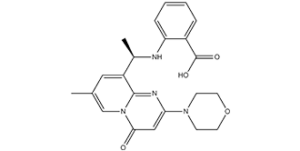AZD-6482 (KIN-193)
This product is for research use only, not for human use. We do not sell to patients.

For small sizes, please check our retail website as below: www.invivochem.com
| Size | Price | Stock |
|---|---|---|
| 250mg | $710 | Check With Us |
| 500mg | $999 | Check With Us |
| 1g | $1500 | Check With Us |
Cat #: V0124 CAS #: 1173900-33-8 Purity ≥ 98%
Description: AZD6482 (KIN193) is a novel, potent, selective and ATP competitive PI3Kβ (phosphatidylinositol-3-kinase) inhibitor with potential anticancer activity.
Top Publications Citing Invivochem Products
Publications Citing InvivoChem Products
Product Promise

- Physicochemical and Storage Information
- Protocol
- Related Biological Data
- Stock Solution Preparation
- Quality Control Documentation
| Molecular Weight (MW) | 408.45 |
|---|---|
| Molecular Formula | C22H24N4O4 |
| CAS No. | 1173900-33-8 |
| Storage | -20℃ for 3 years in powder formr |
| -80℃ for 2 years in solven | |
| Solubility In Vitro | DMSO: 82 mg/mL (200.75 mM)r |
| Water:<1 mg/mLr | |
| Ethanol: 10 mg/mL (24.48 mM) | |
| Solubility In Vivo | 30% PEG400+0.5% Tween80+5% Propylene glycol: 30 mg/m |
| SMILES Code | O=C(O)C1=CC=CC=C1N[C@@H](C2=CC(C)=CN(C2=NC(N3CCOCC3)=C4)C4=O)C |
| Synonyms | AZD6482; AZD-6482; AZD 6482; KIN-193; KIN193; KIN 193 |
| Protocol | In Vitro | An in vitrokinase assay demonstrates that AZD 6482 (KIN-193) is highly potent in the inhibition of p110β’s kinase activity (IC50 of 0.69 nM) and has 200, 20, and 70-fold selectivity over p110α, p110δ, and p110γ isoforms, respectively. AZD 6482 also exhibits selectivity of ~80 fold over PI3K-C2β and DNA-PK and more than 1,000-fold over other phosphatidylinositol-3 kinase–related kinases (PIKKs). An inhibitor-kinase interaction profiling of AZD 6482 against a panel of 433 kinases using the KinomeScan approach demonstrates that AZD 6482 is highly selective in its interaction with PI3Ks. To determine whether AZD 6482 selectively targets PTEN-deficient tumors, the effect of AZD 6482 is tested on cell proliferation on a large panel of 422 cancer cell lines using high-throughput tumor cell line profiling. 35% of cell lines with PTEN mutations (20 out of 57) and 16% of cell lines with wild-type PTEN (58 out of 365) are sensitive to AZD 6482 with a threshold of EC50<5 µM. |
|---|---|---|
| In Vivo | To determine the pharmacodynamics of AZD 6482 (KIN-193) in tumors in vivo, rat fibroblast (Rat1) cells are engineered to express both p53DD, a dominant negative mutant of p53, and a constitutively activated myr-p110β (Rat1-CA-p110β) to enable these cells to form xenograft tumors in mice. For comparison, an isogenic Rat1 cell line expressing p53DD and myr-p110α (Rat1-CA-p110α) is also generated. Rat1-CA-p110α and Rat1-CA-p110β cells are introduced subcutaneously into the contralateral flanks of athymic mice such that tumors driven by activated p110α or p110β would be exposed to identical conditions and that concern about animal-to-animal variability could be eliminated. When tumors reach a volume of ~500 mm3, the tumor-bearing mice receives a single IP injection of AZD 6482 (10 mg/kg). The plasma concentration of AZD 6482 is highest at 1 hour post-injection and declined to undetectable levels by 4h. Concentrations of AZD 6482 in both the CA-p110α- and CA-p110β-driven tumors parallel the plasma concentrations. Analyses of tumor lysates harvested at various time points after AZD 6482 injection reveal that the phosphorylation of AKT is significantly reduced at 1hour after AZD 6482 injection in Rat1-CA-p110β tumors, but remain unchanged in Rat1-CAp110α tumors. |
These protocols are for reference only. InvivoChem does not
independently validate these methods.
| Solvent volume to be added | Mass (the weight of a compound) | |||
|---|---|---|---|---|
| Mother liquor concentration | 1mg | 5mg | 10mg | 20mg |
| 1mM | 2.4483 mL | 12.2414 mL | 24.4828 mL | 48.9656 mL |
| 5mM | 0.4897 mL | 2.4483 mL | 4.8966 mL | 9.7931 mL |
| 10mM | 0.2448 mL | 1.2241 mL | 2.4483 mL | 4.8966 mL |
| 20mM | 0.1224 mL | 0.6121 mL | 1.2241 mL | 2.4483 mL |
The molarity calculator equation
Mass(g) = Concentration(mol/L) × Volume(L) × Molecular Weight(g/mol)
Mass
=
Concentration
×
Volume
×
Molecular Weight*
The dilution calculator equation
Concentration(start)
×
Volume(start)
=
Concentration(final)
×
Volume(final)
This equation is commonly abbreviated as: C1 V1 = C2 V2
Concentration(start)
C1
×
Volume(start)
V1
=
Concentration(final)
C2
×
Volume(final)
V2
Step One: Enter information below
Dosage mg/kg
Average weight of animals g
Dosing volume per animal µL
Number of animals
Step Two: Enter the in vivo formulation
%DMSO
+
%
+
%Tween 80
+
%ddH2O
Calculation Results:
Working concentration:
mg/ml;
Method for preparing DMSO master liquid:
mg
drug pre-dissolved in
µL
DMSO(Master liquid concentration
mg/mL)
,Please contact us first if the concentration exceeds the DMSO solubility of the batch of drug.
Method for preparing in vivo formulation:
Take
µL
DMSO master liquid, next add
µL
PEG300, mix and clarify, next add
µL
Tween 80,mix and clarify, next add
µL
ddH2O,mix and clarify.
Note:
- (1) Please be sure that the solution is clear before the addition of next solvent. Dissolution methods like vortex, ultrasound or warming and heat may be used to aid dissolving.
- (2) Be sure to add the solvent(s) in order.




































